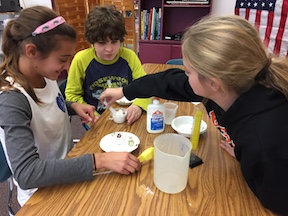Murray, a TNSM 2nd grader, enjoys reading books and recommended the “Flat Stanley” series by Jeff Brown. Murray likes the books because it’s fun to see all the things Flat Stanley can do like slide under doors, hide in a picture frame and get mailed to a friend in an envelope. Murray said, “I especially like the pictures and the funny words like Phooey!”
Auction info
Click this link to purchase tickets, sponsor a teacher or to make a cash donation. The Event of the Year! March 18, 2017 6:00 pm Rhinegeist Brewery in Over-the-Rhine (1910 Elm Street) We hope you’ll join us for a wonderful party where we’ll gather with current and past staff and parents, adult alumni and friends for a fun-filled evening.
TNSM teacher, Johnnyé White, invited Stephanie Rechtin as a guest speaker.
Johnnyé often brings speakers to her elementary Appreciating Difference Classes to encourage children to learn about people’s differences and to be comfortable asking questions. Stephanie Rechtin was born with cerebral palsy and Asperger’s. Although speaking, walking and visual processing are more difficult for Stephanie because of her disabilities, she says that other tasks come quite easily for her. For instance, Stephanie was reading at the age of 3 and attended school with her peers, studying English and psychology in college. Just like all of us, Stephanie uses gadgets to help her in areas where she is weak. She uses …
Pauses, Promises and Miles to Go
This time of year we often find ourselves in moments of reflection. Lists of the year’s momentous events are published through news outlets, new calendars are purchased, and even in our own personal lives we reflect on our accomplishments and challenges over the past 12 months. This year at The New School Montessori, some of our families brought new lives into the world, while others lost someone close to them. Each year provides us with a multitude of reasons to be grateful, as well as moments to grieve. Wherever you are on this journey, we wish you joy and peace …
Study of mixtures and solutions
During the month of January, teacher Nancy Buchman and her 4th-6th grade scientists will explore mixtures and solutions. Both mixtures and solutions are made up of two or more substances, but mixtures can be separated using hands, magnets, sifting, or filtering. The students’ test tubes contain water mixed with sand, sugar, or cobalt chloride. Can you guess which is the mixture that can be separated by filtering, and which is a solution that will pass right through the filter paper? These eager scientists can share their results with you.
Kindergartners, Kandinsky and Stravinsky!
TNSM art teacher, Ryonen Ignatius, led kindergarten art students in their study of Kandinsky and his use of geometry, line, composition and color theory to create an exciting multimedia spiral collage. They listened to another artistic iconoclast–Igor Stravinsky–as they created their vibrant designs.
Students form a solid and observe an exciting chemical change
In chemistry class, 4th-6th grade students are discovering the tell-tale signs of a chemical change. One of them is the formation of a solid. This week, our student chemists mixed together water, borax, glue, and cornstarch and had fun watching the gooey mess turn into bouncy balls.
Get the lawnmowers out, there’s some trimming to be done
Kindergartners have been studying germination in their botany class with Colleen. A number of weeks ago, students planted seeds in clear plastic cups. Colleen took their pictures and placed each child’s photo strategically on the cup’s edge so that it looks like students are in need of a “haircut.” With each passing day, their grassy “hair” grows longer and longer. Colleen asked the kids to imagine clover and grass growing on their heads as she took their pictures. It’s fun to see their creative poses.
Robots created according to perimeter and area spec sheet
Third level students reviewed concepts of perimeter and area by creating robots on graph paper. Their creativity was constrained only by the requirement that they maintain a certain perimeter and area for an arm, leg, torso or head.









